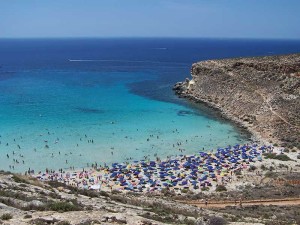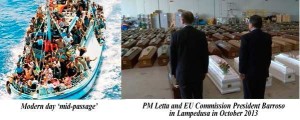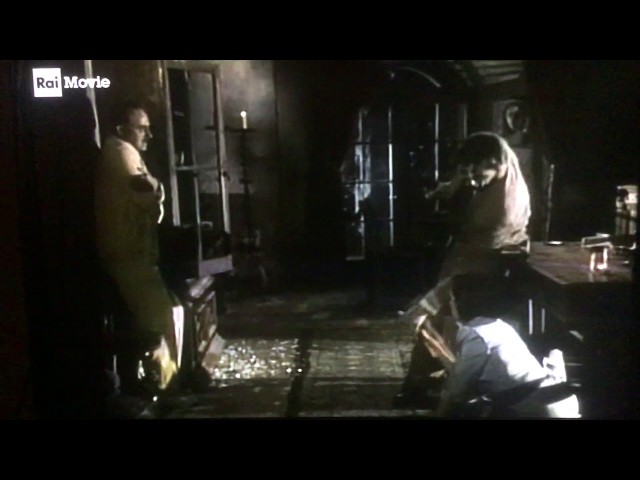Migrants’ Holocaust: the second anniversary of the greatest migrants’ tragedy of the XXI century
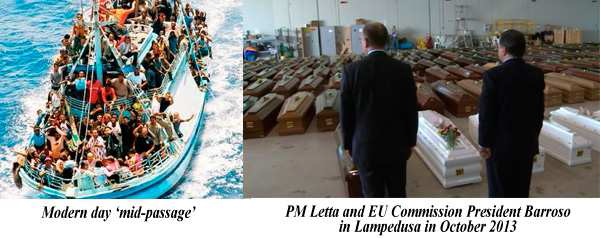
On October 3, 2015 the tiny island of Lampedusa, South of Sicily, celebrated the second anniversary of the greatest migrants’ tragedy since the beginning of the century. 2,000 people marched through the street of Lampedusa sending out an appeal to Europe “to maintain the saving of human lives as a priority in the Mediterranean and to provide legal ways to avoid people to risk their lives at sea”. Some survivors, that have now found their place in European countries, came back to their D-day location, that now consider their second homeland, to meet the Lampedusa families who helped them and that they regard as “second parents, brothers and sisters”. That huge shipwreck (366 established casualties) was followed by many others: about 3,000 migrants have died since the beginning of 2015.
What follows are some background considerations on a phenomenon that may be easily defined as migrants’ holocaust, a sort of contemporary ‘middle-passage’ from Africa and the Middle-East to Europe, whose full scale tragedy is more clearly visible from a ‘front-line’ country like Italy. In here, we stare into the migrants‘ lost scared eyes every single day, but most of us rarely feel guilty, least of all the detached world of politics.
In October 2013 I was writing my book on Berlusconi’s Italy: in the second part of this post I quote the passage of the book I dedicated to the tragedy that I witnessed in real time.
The modern Middle Passage
It is one of the most-frequented destinations of sun-worshippers, scuba-divers and nature lovers, and it is the last trace of Italian terrain before the African coast. Lampedusa, glorious, sun-bleached island south of Sicily, helps to create the Pelagian Archipelago (“islands of the high sea” in Greek etymology) … A borderland straddling two worlds, Lampedusa contains within it the environmental characteristics of two continents: it is, after all, only 70 miles from Tunisia, and 109 miles from Sicily (www.italia.it, English version)
Lampedusa indeed is a symbolic border between Europe and Africa. It is a holiday dream destination if you come from the opulent cold North, but if you arrive from the South on a ‘desperate’ boat searching for a way to survive, its lighthouse looks like the Statue of Liberty. For the exhausted migrants who make it, Lampedusa rises high expectations and generates great fears at the same time, like Ellis Island used to do when we Europeans took similar biblical voyages of hope at the end of the XIX century.
At least since the 2013 migrants’ slaughter, when we saw almost 400 people drowning a few meters away from the marvelous beach of the Island of the Rabbit where tourists were enjoying the clear blue warm Mediterranean waters, that small island has become the very symbol of this contemporary humanitarian tragedy for the Italians. As I have just said, we have seen an escalation of migration after that date: more than 580,000 migrants and refugees have reached the European Union by sea so far this year, according to the International Organization for Migration. In these very months we are witnessing the miserable spectacle EU institutions are giving out on that matter. The recent erection of walls in Eastern European nations – that reminds us, ineluctably, of the Shoa – has taken place while the endless European institutions’ meetings, to discuss common strategies and national migrants’ quota, have always ended without any real agreement and Italy and Greece are left alone in handling the crisis once again. Actually, last month the European Union approved a relocation program meant to help the union’s front-line countries. The program is meant to move 160,000 asylum seekers, now sheltering in Greece and Italy, to other European countries over the next two years. The European nations also agreed to set up ‘hotspots’ – identification centres in the arrival locations – in Italy and Greece and accept refugees escaping from wars and political persecution. These asylum seekers will be transferred to hosting countries regardless of the refugees’ will. All the other migrants, the majority, running away from starvation, are going to be sent back home to their marked sad fate. But this is a just a drop in the vast sea of need and emergency that won’t change the migrants’ holocaust.

as part of a plan to move 160,000 asylum seekers.
Credit Andreas Solaro/Agence France-Presse — Getty Images
On October 9, 2015 we have seen the first 19 asylum seekers, after being identified by the Lampedusa new ‘hotspot’, leave Rome on a government plane bound for Lulea, on the Gulf of Bothnia in Sweden, about 1,680 miles to the north, where the Swedish authorities awaited them to process their asylum requests. Lulea, the main city in Swedish Lapland, couldn’t be more different from the Eritreans’ desert-covered homeland and sunny Lampedusa. Temperatures are now already below freezing and outside the city, reindeer, moose and bears roam in the wilderness. The Italian Interior Minister Alfano and the European Commissioner for Migration and Home Affairs Avramopoulos were there smiling at the cameras, but the event was just another facade for the media’s sake. As the Christian Church has underlined with an unknown vehemence, surely thanks to pope Francis’s progressive attitude in social matters, politics is just watching, it is absent, and has forgotten the spirit of solidarity of Christianity, whose roots Europe is so proud of. The self-proclaimed centre-left Renzi government has done nothing to cancel or replace the racist anti-immigrants laws of the Berlusconi age.
Once again, the West is forgetting its historical faults in creating world poverty outside and inside the Old Continent. It may seem banal or old-fashion to remind it, but this is implicit in the liberal societies whose statute books define exploitation and profit as pillars of society, the contrast between the poor and the rich at home the other side of the disparity between the North and the South of the world.
Death by Water
The following is the extract from part 3, chapter 1 of SilvioBerlusconi’s Italy written on the day after the tragedy (October 4, 2013):
The following day I’m driving home in the late afternoon. The sky is cloudy and it looks like rain. Not so in the small island of Lampedusa, south of the Sicilian coast, one of the southernmost stretches of land in Europe where summer never ends. It’s the radio again that informs me of the tragic events of the day, taking me back to the real country and making me forget all about yesterday’s political [Berlusconi’s] ‘sceneggiata’ and its detachment from the real world. Lampedusa is a gateway to Europe for African people that risk their lives to cross the Mediterranean in search of hope, of survival from wars, famine and dictatorships. No matter the price, they are willing to risk it all for a chance in the future. Desperation and hunger carry them forward: they would perish anyway in their homeland. It’s a contemporary version of the ‘middle-passage’ that brought African slaves to America, the ‘land of milk and honey’. Today a boat carrying hundreds of illegal migrants from Libya sank off one of the island’s beaches where rich tourists were spending their holidays, sun tanning and swimming in the same waters in which the migrants were drowning. It’s another snapshot of Italy’s Inferno, a wonderful surface that conceals the suffering and desperation of a society rotten to the core. The emergency response of the Italian Coast Guard rescued 155 survivors. The death toll after searching the boat was 366 but further bodies are still missing, lost in the Mediterranean Sea, the largest cemetery in the world. This is just one episode of a tragic story that has been going on for decades, and we have got so used to it that only when a tragedy of today’s dimension takes place we notice it and pity and pray and listen to the politicians talking in vain. When these people arrive on Italian soil they are sent to prison-like ‘centri di accoglienza’ – welcome centres –, then accused of illegal immigration and trialed, then sent back home. The ones who manage to escape become illegal extracomunitari either enslaved by the mafia or destined to the labour black market, to do the jobs the Italians don’t want to do anymore, and they are often discriminated like in the American Deep South of the 50s. The immigrants who survived told the authorities they had to pay 3,500 euros to the local bosses in Africa, then they were sent to ‘concentration camps’ established in the no-man’s-land desert zone near the Libyan border. There, all women, also the ones with children, were raped and beaten. Afterwards, they were taken to the coast and had to pay 1,500 additional euros to cross over to Lampedusa. One of their masters was later recognized by the migrants, there was an attempt to lynch him and he was finally arrested. What Berlusconi’s government has produced on the topic is a law called ‘Bossi-Fini’ which introduced the crime of illegal immigration and expulsion in a blind attempt to stop the ‘invasion of the body snatchers’. Fini was the acclaimed leader of the post-fascist ‘Alleanza Nazionale’ party and Bossi the historical leader of the racist party ‘The Northern League’. One of its members has recently published a picture of the Secretary for Integration, the coloured Ms Kyenge, with a chimpanzee head in his Facebook profile. Angelino Alfano [deputy Prime Minister and Interior Minister] was in Lampedusa the day after, Enrico Letta [Prime Minister] and European Commission’s President José M. Barroso were there a few days later, amid the inhabitants’ boos, proclaiming to the world media that they would take immediate action: so incisive their acts were that a new shipwreck, that occurred 120 kilometres from Lampedusa on October 11, caused 34 new casualties. Actually a few weeks later the Letta government would establish a task force in the Italian waters, called ‘Mare Nostrum’, to take care of the problem: compared to Berlusconi’s right wing governments, as extremist and anti-welfare as the American ‘tea-party’, the Letta all-DC government [DC, ‘Democrazia Cristiana’, the centre party that dominated Italian politics until the early 90s] is showing a pale attention to social care, even if the privileged are not touched by its acts at all. It’s indeed a fake democracy a society that is not able, or is not willing, to deal with the real social problems and to pursue social justice, a political caste only self-centred, interested in its own survival, in the maintenance of its benefits, engaged in byzantine palace games completely detached from everyday life.
In 2014 the number of illegal migrants who tried to reach Sicily from Libya increased dramatically and that stretch of water became the invisible cemetery of this contemporary holocaust. ‘Mare Nostrum’ saved a lot of lives, but it was not enough, since the Middle-East and North-African war zones kept pushing those desperate men away from their homeland. All that democratic, Christian, ‘welfare’ EU was able to do was to plan to substitute ‘Mare Nostrum’ with a EU directed operation called ‘Frontex Plus’, an enterprise with very limited funds and means.
Bambine reali
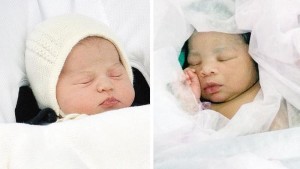
Francesca Marina, born on an Italian navy vessel (right – Photo Marina Militare);
Royal princess named Charlotte Elizabeth Diana (left -Photo: BBC)
I’d like to finish this post with this juxtaposition of images. On one side her highness Charlotte Elisabeth Diana, of royal blood, on the other one Francesca Marina, named after the Italian Marina Militare by the crew who helped her to be born in between the waves on the rotten migrants‘ boat upon which her mother was trying to escape from the unspeakable horror she had seen in Nigeria. They were born on the same day in Europe, May 2, 2015, in the far North and in the deep South of the same continent, in those United States of Europe that should guarantee the equal rights granted by the American Declaration way back in 1776. “Sarà interessante ritrovare queste due bambine tra trent’anni e scoprire se le differenze abissali che oggi le separano si saranno almeno ridotte. Attraverso il loro cammino potremo misurare quello dell’umanità” wrote columnist Massimo Gramellini on 5.5.2015 in the Turin daily La Stampa in an editorial titled Bambine Reali (‘reali’ means both ‘real’ and ‘royal’, so the pun is real/royal babies. “It will be interesting to find these two babies again in thirty years and discover if the abyssal differences that today separate them will have diminished at least. By their walk in life we will be able to measure that of the human kind”).
Dear reader, if you care about this common tragedy, please help spread this article by sharing it on your social media. Knowledge is as important as action, and you are just a few clicks away from it. Thank you
